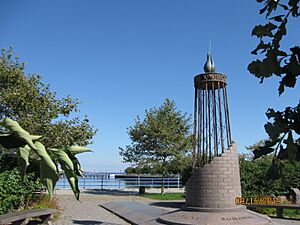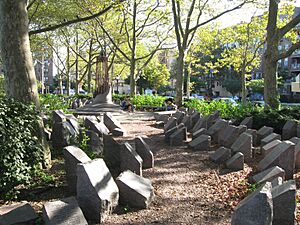The Holocaust Memorial Park facts for kids
The Holocaust Memorial Park is a special public park in Brooklyn, New York City. It sits by the water in an area called Sheepshead Bay. Many Jewish people, including those who survived the Holocaust, moved to nearby neighborhoods like Sheepshead Bay, Manhattan Beach, and Brighton Beach after World War II.
This park is the only public memorial in New York City dedicated to the Holocaust. The City of New York owns the park, and the Parks Department takes care of it. A group called "The Holocaust Memorial Committee" helps manage the special markers inside the park.
Contents
How the Park Began
The Idea for the Memorial
Two people from the Manhattan Beach community, Alfred Gollomp and Ira Bilus, had an important idea. They wanted to create a memorial park for the Holocaust. They talked to the mayor at the time, Edward I. Koch. The mayor liked the idea and found a perfect spot for the park.
Building the Park
Next, Gollomp and Bilus spoke with Howard Golden, who was the Brooklyn Borough President. He helped get $933,000 to build the park. For the next two and a half years, they worked on the park's design and what words would be written there.
The park was officially named Holocaust Memorial Park in 1985. A special ceremony was held, and about 8,000 people attended. A famous Holocaust survivor and Nazi hunter, Simon Wiesenthal, was the main speaker. Construction started in 1986, and the memorial was dedicated that same year. Many important people, including Mayor Koch and Abraham Foxman, who was also a Holocaust survivor, were there.
What You See at the Memorial
Main Design Features
The memorial was designed by a landscape architect named George Vellonakis. It has a tall sculpture, about 14 and a half feet high. This tower is made of granite and steel. On top, there is a bronze "Eternal Flame," which is a flame that never goes out. The word "Remember" is written around the top of the tower.
The tower stands on three round granite bases. These bases have the names of countries where people were persecuted during the Holocaust. A long granite slab, about 21 feet long, tells a short history of the Holocaust. Alfred Gallup wrote this history.
A Message of Remembrance
At the end of the long slab, there is an important message:
"This memorial is dedicated to the lasting memory of the six million Jewish people—men, women, and children—who were cruelly murdered by the Nazis and their helpers during the Holocaust.
It also remembers the five million other innocent people who were killed under German rule during World War II. We honor the brave heroes of the ghettos and those who fought back. We remember the partisans and soldiers who fought for freedom. This memorial is for those who survived the terrible events of the Nazis. It is for the few good people who risked their lives to protect those in danger. And it is for everyone who fights for freedom and human dignity. People must learn, understand, and remember so that such terrible things never happen again. Remember!"
Granite Markers and Their Meaning
On both sides of the tower, there are two gardens with 234 granite markers. These markers have names, places, and historical events related to the Holocaust written on them. They look like tombstones with broken edges. This design reminds us of the shattered lives of Holocaust survivors. Each marker is different in shape and size, showing that all the people persecuted by the Nazis were unique.
People can have the names of friends or family members who were lost during the Holocaust added to these markers. To do this, they make a donation to the Holocaust Memorial Committee. The committee checks the information to make sure it is real. Thousands of names have already been added to these granite markers.
What's Written on the Markers
The granite markers include names of places like Auschwitz, Bergen-Belsen, Buchenwald, and Dachau concentration camp. These were all concentration or extermination camps.
They also list important events, such as the Wannsee Conference, the Death Marches, Kristallnacht, and the Warsaw Uprising.
You can also find names of people like Anne Frank, Raoul Wallenberg, and Elie Wiesel. Poems and messages from famous people like Abraham Sutzkever and Dwight D. Eisenhower are also included. Many Jewish communities from before the war are remembered too.
Annual Gatherings
Since the park was dedicated, special gatherings happen there throughout the year. These events are for remembering the past, holding memorial programs, and honoring leaders, teachers, and brave figures. One important day for these gatherings is International Holocaust Remembrance Day.
External links
- The Holocaust Memorial Committee
- The Holocaust Memorial Committee facebook page



